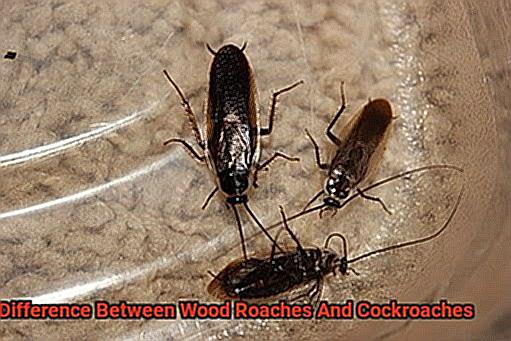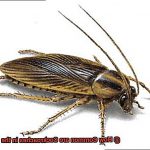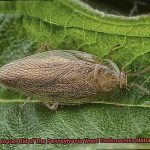Have you ever had a heart-stopping moment when you spot an insect scurrying across your kitchen floor, and wonder if it’s a wood roach or a cockroach? If you have, don’t worry – it’s a common predicament. These bugs share similar characteristics that can make it tricky to distinguish them apart. However, knowing the difference can help you take appropriate action if you’re dealing with an infestation.
In this post, we’ll explore how to differentiate between wood roaches and cockroaches based on their physical features, habitat, and behavior. We’ll cover everything from their body shape and size to their color and preferred living environments.
But before we dive in, let’s start with some background information. Cockroaches are infamous household pests that can spread diseases and trigger allergies.
On the other hand, wood roaches only appear occasionally and are commonly found in wooded areas. By learning how to tell these insects apart, you’ll be better equipped to deal with any potential problems that may arise.
So, let’s get started.
Physical Characteristics of Wood Roaches
Contents
These critters have several unique physical characteristics that make them stand out from the crowd.
Firstly, wood roaches are larger than other types of cockroaches, measuring an average length of 1.25 inches. Their flattened body and long antennae, almost as long as their body, give them a distinct appearance. They’re also light to dark brown in color, which enables them to camouflage well in their preferred habitat.
However, the most easily recognizable characteristic of wood roaches is their wings. Unlike other roach species, their wings extend beyond their body and are great fliers, allowing them to travel quickly and easily from one location to another. This mobility is essential for their preferred habitat of wooded areas with lots of trees and vegetation.
It’s worth noting that wood roaches do not usually infest homes or buildings like other cockroach species. They prefer to live outside under logs, rocks, and debris. However, homeowners may occasionally encounter them indoors by accident, causing a bit of a scare due to their large size.
To prevent wood roaches from entering your home inadvertently, you can take practical steps such as sealing cracks and gaps around doors and windows. Regular cleaning and proper food storage practices can also minimize the attraction of indoor spaces for other types of cockroaches.
By understanding the physical characteristics and behavior patterns of wood roaches, you can better protect your home from infestations and reduce health risks associated with these pests.
Physical Characteristics of Cockroaches
Cockroaches are incredible creatures that have been thriving for over 300 million years. With a whopping 4,000 species, only a handful are considered pests. But what sets these critters apart? Let’s delve into the fascinating physical characteristics of cockroaches.
Firstly, cockroaches have an oblong, flattened body with six legs and two antennae that act as navigational aids. Their hard exoskeleton, made of tough chitin, shields them from predators and prevents water loss. The body is segmented into three distinct parts: the head, thorax, and abdomen. The head houses their mouthparts and compound eyes made up of numerous small lenses.
Cockroaches come in different sizes ranging from under an inch to over two inches in length. They can be brown, black, or reddish-brown in color. Some species sport wings that extend beyond their bodies like remarkable capes while others do not.
One of the most outstanding physical characteristics of cockroaches is their lightning-fast speed across surfaces. They can travel at speeds of up to three miles per hour, making it tricky to catch them.
So why is it essential to understand the physical characteristics of cockroaches? Knowing what they look like and how they move can help identify them and take appropriate measures to control them in your home or business.
Habitat Preference
When it comes to the habitats of wood roaches and cockroaches, it’s like comparing two different professions. Wood roaches are the lumberjacks of the insect world, preferring to live in damp and dark environments such as under logs or tree bark. They are attracted to light and can often be seen flying towards light sources at night. On the other hand, cockroaches are like chefs; they love warm and moist environments such as your kitchen or bathroom. They are nocturnal creatures that hide in cracks and crevices during the day and are attracted to food sources.
It is essential to note that wood roaches may occasionally find their way into homes, but unlike cockroaches, they do not infest them. Wood roaches are harmless to humans, while cockroaches carry diseases and can cause allergic reactions in some people.
To keep wood roaches out of your home, seal any cracks or openings around windows, doors, and foundations. Keep your home clean and clutter-free, especially in areas where wood roaches may be attracted to like basements or attics.
To prevent cockroach infestations, it’s crucial to keep your home clean and dry. Store food in airtight containers and regularly clean up any spills or crumbs. Cockroaches can enter your home through cracks or openings, so seal them up and eliminate any sources of standing water. If you suspect a cockroach infestation, contact a professional pest control service for effective treatment options.

Behavioral Differences
Imagine wandering through a dense forest, and stumbling upon two creatures that look almost the same. It’s hard to tell them apart, but one is a lumberjack and the other is a chef. Although their physical features may be similar, they have different behaviors. The same goes for wood roaches and cockroaches.
Wood roaches are like lumberjacks: they love living in damp and wooded areas. They are diurnal creatures that are active during the day and attracted to light. They feed on plants, decaying matter, and insects. Cockroaches are like chefs who prefer dark and moist areas like kitchens and bathrooms. They are nocturnal scavengers that can eat almost anything, including garbage, food crumbs, and even soap.
While wood roaches are outdoor insects that pose no harm to humans or animals, cockroaches can carry diseases like salmonella, E.coli, and typhoid fever. They can also trigger asthma and allergies in some individuals.
So how can you distinguish them? Observe their behavior. Wood roaches are more active during the day and rest at night, while cockroaches are active at night when they forage for food. Wood roaches are attracted to light and can often be found near porch lights or outdoor light fixtures, while cockroaches usually avoid light and prefer dark areas.
In conclusion, understanding the behavioral differences between wood roaches and cockroaches is crucial for identifying which type of insect you are dealing with. Remember to keep your home clean and dry by storing food in airtight containers, cleaning up spills or crumbs, sealing cracks or openings, eliminating sources of standing water, and seeking professional pest control services if necessary.
Control and Prevention Methods for Wood Roaches
Wood roaches may look similar to other types of roaches, but they have different behavior and habitat. Are you dealing with a wood roach infestation? Worry not. In this article, we will explore various control and prevention methods for wood roaches that can help you get rid of them and keep them from returning.
Eliminate Food Sources
The first step to controlling wood roaches is to eliminate their food, water, and shelter sources. This requires keeping your home clean and free of clutter, sealing cracks and crevices in walls and floors, and repairing any leaking pipes or faucets.
You can also use baits that contain a slow-acting poison that attracts the roaches. When they consume the bait, they take the poison back to their nests, killing the rest of the colony.
Insecticides
Insecticides are another effective method of control that can be applied as a spray or dust around the perimeter of your home or in areas where wood roaches are likely to hide. To prevent wood roaches from entering your home, you should seal all cracks and crevices in your home’s exterior, install screens on windows and doors, and keep outdoor lights turned off at night.
Natural Remedies To Get Rid of Roaches
There are several options available such as diatomaceous earth, boric acid, or essential oils like peppermint or eucalyptus. Diatomaceous earth is a powder made up of fossilized remains of aquatic organisms. It works by dehydrating the roaches when they come into contact with it.
Boric acid is a natural insecticide that damages the outer skeleton of the roach causing it to dehydrate and die. Essential oils like peppermint or eucalyptus work by repelling the roaches with their strong scent.
So, controlling and preventing wood roaches requires a combination of methods that target their food, water, and shelter sources while also preventing them from entering your home.
Control and Prevention Methods for Cockroaches
Cockroaches are a common household pest that can wreak havoc on your health and home. These creepy crawlies can spread disease, trigger allergies and contaminate food, making it essential to take measures to prevent their infestation and control their population if they have already infested your home.
The first step in preventing cockroach infestations is maintaining cleanliness and hygiene in the house. Cockroaches thrive in dirty environments, so keeping your home clean and clutter-free is crucial. Regularly vacuuming and sweeping floors, wiping counters and surfaces, and washing dishes can help eliminate food sources for cockroaches, making your home less appealing to them.
Another significant measure to prevent cockroach infestations is sealing entry points. Cockroaches can sneak into homes through cracks, gaps, and openings in doors, windows, walls, and pipes. Sealing these entry points with caulk, weatherstripping or mesh screens can prevent their entry and keep them out of your home.
Using baits and insecticides can also be effective in controlling cockroach populations. Baits are a form of poison that cockroaches feed on and bring back to their nests, killing other cockroaches. Insecticides can be sprayed directly on cockroaches or around their hiding places to kill them.
However, if the infestation is severe or if you’re not confident about handling it yourself, seeking professional help is always a good idea. Professional pest control services can provide thorough inspections and treatments of cockroach infestations using advanced methods such as heat treatments, fumigation or physical removal to get rid of the population.
Preventing cockroach infestations requires a combination of cleanliness, sealing entry points, using baits and insecticides, and seeking professional help if needed. By following these methods regularly, you can ensure a healthy and hygienic living environment for you and your family. Remember that prevention is always better than cure when it comes to cockroach infestations.
7FH1UxcWjyY” >
Conclusion
In conclusion, correctly identifying whether you have a wood roach or a cockroach infestation is crucial. Although these insects share some physical similarities, such as their oblong shape and antennae, they have different habits and prevention methods.
Wood roaches prefer damp and wooded areas outside during the day and are attracted to light. On the other hand, cockroaches love warm and moist environments indoors and are nocturnal scavengers that can eat almost anything.
To prevent an infestation of either insect type, it’s essential to keep your home clean and free of clutter, seal cracks and crevices in walls and floors, repair any leaking pipes or faucets, eliminate food sources for insects, use baits or insecticides if necessary. Seeking professional pest control services is also an option if you’re unsure how to proceed.
Remember that preventing an infestation is always better than dealing with one after it has started.






